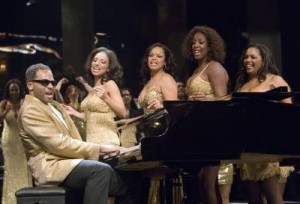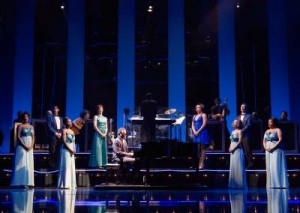
Combining the appeal of the Oscar-winning hit film Ray with the dynamic live
theater format of Jersey Boys, the Pasadena Playhouse has a surefire hit on its
hands with Ray Charles Live!, written by Suzan-Lori Parks, directed by Sheldon
Epps, and featuring over two dozen hits made famous by the man of soul himself.
Like Jersey Boys, Ray Charles Live! is narrated by its title character as he looks
back at his life to tell us his story, warts and all. We first see Ray (Tony nominee
Brandon Victor Davis in an absolutely magnificent star turn) alone at a grand
piano, a spotlight illuminating him on the darkened stage. But soon the lights
surrounding the proscenium start flashing, the stage is illuminated in radiant red,
and Ray is joined by the Raeletts in the infectious church-inspired call and
response of his signature hit, “What’d I Say.”
Soon, though, the lights dim and we are in a recording studio (heaven? hell?)
where Ray is “back to record one more record, ‘Ray Charles Live!,’” the story of
his life. “I’m inviting folks from my life to sit in and sing on this album,” he tells us,
and in fact many of his greatest hits are performed by the main characters in his
life story: Retha, his mother; Della, his wife; his girlfriends Mary Ann and Margie, of
the Raeletts; Ahmet Ertegun, the producing genius who first recorded him; and
Jeff Brown, his first (and later ousted) manager.
We meet Ray as a young boy (played by Jeremiah Whitfield-Pearson), growing
up in 1930s Florida, so poor that “when we ate hog, we ate everything but the
oink.” Ray was dealt a difficult double whammy as a child, first witnessing his
younger brother George drown (“I saw it happen and I froze”), and then over
the course of a difficult year, losing his sight. (“I lost my sight the same way I
became famous … gradually.”) But always there was the music, and even as a
young child Ray demonstrated a prodigious talent at the piano, which he
played every Sunday at church.
A teenaged Ray (portrayed at age 16 by the excellent Wilkie Ferguson) moved
to Jacksonville (“the big time”) in search of fame and fortune, but was told by
bandleader Lucky Millinder that he wasn’t good enough. “His words hit me like a
bolt,” Ray tells us, but giving up was not in Ray’s vocabulary. He played backup
piano to the Jacksonville Men, The Jacksonville Folks, and in an amusing bit,
even yodeled along to the harmonies of the country music group The
Jacksonville Playboys.
Moving to Seattle (the farthest point from Jacksonville in the continental U.S.),
Ray started on a self-destructive path of sex, alcohol, and drugs. (In a disturbing
scene, we see Ray shooting heroin for the first time.) A young Turkish-American
record label owner named Ahmet Ertegun (who was to become a recording
industry legend) signed him for Atlantic Records as part of his vision of bringing
black artists to a larger audience.
Ray also met and fell for Della B (the dazzlingly lovely and golden-throated Nikki
Renee Daniels), whom he married but was never faithful to. “I would have a lot
of women, but only one wife,” he tells us rather self-servingly, though ladies’ man
Ray has no difficulty telling mistress/Raelett Mary Ann (Angela Teek in a wow of
a performance) that she should be happy being his “road wife,” who gets him
every day as opposed to Della, who is lucky to see Ray on Christmas.
No woman was safe from (or immune to) Ray’s “wrist method” of seduction (see
the show to catch a demonstration). As one of the Raeletts tells us, “To be a
Raelett, a girl’s got to ‘let Ray.’” Amazing, then, to hear Ray insist that “nothing
in my road life intrudes on my home life,” a statement to which wife Della would
beg to disagree.
Ray’s blend of “Sunday church music with Saturday night blues” made him a
star, but drugs were nearly his downfall. Only money kept him from a prison
sentence when he was arrested in 1965 for possession of heroin.
Suzan-Lori Parks’ well-written book gives us Ray Charles the man, and not just Ray
Charles the superstar. For Ray, coffee meant “two parts java and three parts
gin.” “I liked making money but I didn’t like spending it,” says the self-declared
“tightwad,” who nonetheless paid his valet’s pricey hospital bills without saying
a word. In an interesting bit, we learn also that all of Ray’s outfits were
numbered, so that he could dress himself in a flash.
Ray Charles Live! is blessed with a powerhouse cast, many of whom get to sing
some of Ray’s most famous hits. The sensational Sylvia MacCalla (Beehive) is a
sultry, sexy blues singer, performing “Barrelhouse Blues,” with little Ray Charles at
the piano. Yvette Cason (dynamic as Ray’s mother Retha) breaks hearts with
“Drownin’ in My Own Tears” after George’s tragic death.
Daniel Tatar (in yet another memorable turn from one of our brightest young L.A.
theater stars) channels his inner nerd as Ahmet Ertegun, and the always
incredible Harrison Brown (Sister Act) portrays Jeff Brown, Ray’s first manager.
Together with Ray (who has cast aside both of them with a self-serving “It’s all
business”), the three of them tear down the house with an emotional “Unchain
My Heart.”
Marvelous Sabrina Sloan is Margie Hendrix, the Raelett who took over lead from
Mary Ann, both in the backup group and as Ray’s main squeeze. Sloan duets
“Don’t Set Me Free” with Angela Teek as the two women engage in an exciting
vocal cat fight for the cheater they both hunger for.
There’s also a hugely emotional rendition of “I Can’t Stop Loving You,” by the
three main women in Ray’s life, a show-stopping performance by Nikki Renee
Daniels, Teek, and Sloan.
There are many other fine performances in Ray, including Meloney Collins and
Nraca as two of the Raeletts; Matthew Benjamin as Tom Dowd, the recording
engineer to whom Ray is telling his life story, (Dowd remains at the recording
studio control panel just left of the stage throughout the entire production);
Maceo Oliver as longtime manager Joe Adams; and Rocklin Thompson and
Ricke Vermont in multiple roles. The spectacular cast is completed by Phillip
Attmore (young Quincy Jones), Aaron Brown/Christopher Brown (Ray’s doomed
younger brother George), Tara Cook, Dionne Figgins, Matthew Koehler, Yusuf
Nasir, and Leslie Stevens. Not a weak link among them.
Finally, and most importantly, there is the superlative performance by
Broadway’s Brandon Victor Dixon as Ray Charles. Physically and vocally, Dixon IS
Ray, and unlike Jamie Foxx’s Oscar-winning turn, it is Dixon’s own voice
(becoming Ray’s) singing “What’d I Say,” “Hallelujah, I Love Her So,” “Moving
On,” “Georgia on My Mind,” “Hit the Road Jack,” and “You Don’t Know Me.”
Like Foxx, it is hard to imagine Dixon not being remembered during awards
season.
The same may well be true for the rest of the Ray Charles Live! team. Sheldon
Epps, the Playhouse’s Artistic Director par excellence, proves himself a
powerhouse of a director in a production which requires real dramatic
performances alongside thrilling song and dance numbers. The latter are the
work of Broadway’s sensational choreographer Kenneth L. Robertson, and
include gospel, jitterbug, frug, and Vegas-inspired dances. Ricardo Hernandez’
set has musical director Rahn Coleman’s soulful, rocking band upstage, the
downstage portion morphing into the many locales where Ray lived his life. Paul
Tazewell’s costumes are as varied and impressive as one might imagine, Donald
Holder’s lighting design combines show biz dazzle with subtle intimate moments,
and Carl Casella and Domonic Sack’s sound design is rock concert worthy.
There’s also video designer Austin Switzer’s ingenious (and subtle) projections on
a transparent scrim, dancing musical notes accompanying the trombones at
one moment, newspaper headlined announcing Ray’s drug bust at another.
Everyone involved in this project is deserving of praise: Coleman for his vocal and
musical arrangements, Charles G. LePointe (hair and wigs), Harold Wheeler
(orchestrations), Zane Mark (dance arrangements), Eric Butler (conductor),
Michael Donovan and Telsey + Company (casting), and finally the rarely
mentioned work of the stage manager, in this case Lurie Horns Pfeffer assisted by
Conwell Worthington III.
At the end of the final reprise of “What’d I Say,” the audience did not even wait
for the lights to rise on curtain call to stand up in cheers and applause at this
thrilling finale to the Pasadena Playhouse’s 2007 season. Defiance, Cuttin’ Up,
The Constant Wife, Can-Can, Matter of Honor, and now the show which may
end up being the biggest hit of all, Ray Charles Live!. It’s been one thrilling and
marvelous season for the Playhouse!
Pasadena Playhouse, 39 South El Molino Avenue in Pasadena.
www.Pasadenaplayhouse.org
–Steven Stanley,
November 14, 2007
Photos: Craig Schwartz




 Since 2007, Steven Stanley's StageSceneLA.com has spotlighted the best in Southern California theater via reviews, interviews, and its annual StageSceneLA Scenies.
Since 2007, Steven Stanley's StageSceneLA.com has spotlighted the best in Southern California theater via reviews, interviews, and its annual StageSceneLA Scenies.







 COPYRIGHT 2024 STEVEN STANLEY :: DESIGN BY
COPYRIGHT 2024 STEVEN STANLEY :: DESIGN BY